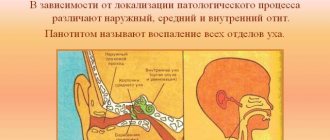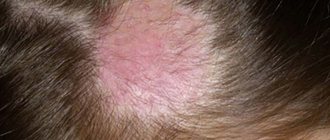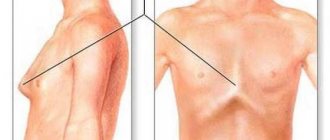Advertisement
The child is coughing, his nose is not breathing , and has a high fever . He could have caught a cold or contracted a viral infection. It could also be bronchitis . How to identify this disease by symptoms? How to treat bronchitis in children and when to consult a doctor to prevent complications? We will deal with all these questions in the article.
Classification
There is a clear division of forms of the disease based on its various characteristics. According to the duration of the course, the following types of bronchitis in children are distinguished:
- acute – usually develops against the background of other infections (ARVI, influenza, rhinitis). Its symptoms appear up to 3 weeks, after which the child fully recovers;
- chronic - characterized by a long-term, unexpressed inflammatory process in the bronchial mucosa with a large secretion of mucus. Its exacerbation occurs with the development of other infections, hypothermia, and breathing polluted air. This diagnosis is made only after a child is 2 years of age or older and shows signs of the disease.
Depending on the cause of the disease, bronchitis is divided into the following forms:
- bacterial;
- viral;
- allergic;
- fungal.
Most often, it is possible to accurately name the causative agent of the disease only after a series of laboratory tests, which is why the general name “infectious bronchitis” is found without indicating the type of microorganism that caused it.
According to the localization of inflammation, there is a division into the following forms:
- tracheobronchitis - tracheal tissue and large bronchi are involved in the pathological process;
- bronchitis - infection of the bronchi of medium and small diameter;
- bronchiolitis - damage to the smallest areas - bronchioles.
Thanks to this classification, the final diagnosis indicates the main characteristics of the disease.
Forms of the disease
Depending on the severity of the course, bronchitis can be mild, moderate and severe.
Depending on changes in the function of external respiration, simple (non-obstructive) and obstructive forms of bronchitis in children are distinguished.
Depending on the duration and characteristics of the course:
- acute – duration 1.5–2 weeks;
- recurrent - occurs 3 or more times a year, is typical for preschool children, with age it tends to develop into chronic bronchitis;
- chronic – symptoms of the disease persist for several months.
Depending on the origin, acute bronchitis can be:
- infectious;
- non-infectious;
- mixed;
- unspecified.
Depending on the mechanism of development - primary and secondary acute bronchitis.
Based on the nature of the exudate, bronchitis in children is divided into catarrhal, purulent, catarrhal-purulent, and atrophic.
The mechanism of development of bronchitis
Normally, healthy human respiratory tracts are cleared of foreign particles by secreted mucus and immune cells. The occurrence of acute bronchitis in a child occurs against the background of decreased immunity due to a primary infection. As inflammation develops, the mucus produced thickens, causing microorganisms or allergen particles to settle on the walls of the organ, causing a local tissue reaction.
It is manifested by spasm of the internal muscles of the lower respiratory tract and swelling of the mucous membrane, which leads to a narrowing of their internal lumen. Thus, bronchial obstruction develops, which leads to breathing problems. In some cases, it manifests itself insignificantly, but in others it can cause pulmonary failure and lack of oxygen.
Non-obstructive bronchitis refers to the chronic form of the disease. With this type of bronchial inflammation, the normal structure of the bronchial epithelium is disrupted. They constantly contain a viscous secretion, which causes chronic cough and shortness of breath in the child. Typically, this form of the disease in the vast majority of cases occurs in children of high school age and adults.
Treatment of obstructive bronchitis
Obstructive bronchitis must be treated immediately; it is important to do everything to restore the patency of the bronchial tube:
- the child must be calm; during stress, respiratory failure increases;
- inhalation. An effective product for thinning mucus in tubes. Blocked organs are released, and breathing becomes easier. If it is not possible to visit a medical facility, you can purchase a pocket inhaler with replaceable cartridges at the pharmacy. The effect occurs literally immediately, after a few minutes. Inhalations should be done every 2-3 hours;
- humidifying the air and increasing the supply of oxygen to the affected organ through inhalation;
- in some cases, doctors recommend infusion therapy, including special solutions and medications. Conducted in a clinical setting;
- Treatment consists of antibiotics, expectorants, immune medications and physical therapy.
Causes of the disease
The main cause of acute bronchitis is the development of an infectious or allergic process in the lower respiratory tract. However, it does not happen by itself. It usually begins with the spread of viruses from the nasal cavity or throat. In some cases, the inflamed mucosa creates an environment for the growth of bacteria. In this case, an acute mixed infection occurs, which creates the possibility of pulmonary obstruction.
For the development of acute bronchitis in children, certain provoking factors are necessary. These include:
- hypothermia;
- habitual mouth breathing;
- passive or active smoking;
- inhalation of toxic substances (acetone, resin, glue);
- ingress of foreign objects;
- malformations of the respiratory system;
- low physical activity;
- the presence of allergic reactions;
- immunodeficiency;
- some systemic diseases (cystic fibrosis, diabetes mellitus).
The presence of these circumstances creates a favorable environment for the growth of colonies of microorganisms. Many of them become reasons for recurrent bronchitis and its transition to a chronic form.
Sometimes the cause of frequent bronchitis in a child can also be increased body weight and low physical activity. In this case, the volume of circulating air in the lungs is reduced, which leads to stagnation. A healthy child needs active movement and sports not only for the development of muscle mass, but also for the proper development of internal organs and skeleton.
Attention! Those children who frequently inhale tobacco smoke or are in unventilated areas are most susceptible to acute and recurrent obstructive bronchitis.
Air polluted with dust and smoke particles very often becomes a factor in the development of diseases of the respiratory system, including asthma, pneumonia, and emphysema.
Causes
The most common causes of cough when the respiratory organs are affected are:
- Hypothermia. A child’s body does not yet have thermoregulation, so walking with a child, especially in the first two years of life, should take into account the air temperature outside and the strength of the wind. The temperature in the room should be at least 20 degrees. It is also not worth dressing a small child too much, since the body may sweat and, in the presence of a draft, will immediately catch inflammation in the respiratory system.
- Teeth. When teething, children may begin to cough. Many parents mistakenly believe that this is normal and do not pay attention. But the baby’s weak immunity and the presence of infection in the bronchi can provoke the development of the disease.
- ORZ. The most common cause of the disease. Viruses that contribute to the development of the disease are as follows:
- flu;
- parainfluenza;
- cytomegalovirus;
- adenoviruses;
- streptococci, staphylococci, pneumococci;
- Haemophilus influenzae.
Infection occurs through airborne droplets, especially if a child attends a preschool or school institution. In very young patients, the development of the disease is caused by microbes that are found on dirty toys or objects on the street.
A cough usually takes a long time to cure, the recovery process can drag on for several weeks, so the causes that contribute to the development of an unpleasant disease should be avoided as much as possible.
Clinical signs of bronchitis in children
Manifestations of the disease in children can be different. This depends on the form and location of inflammation, the age of the child, the duration of the course and the cause of the disease. The most common causative agent of the disease is a virus (up to 80% of cases). A distinctive symptom of bacterial bronchitis is the presence of yellow or greenish purulent sputum.
In this case, you need to immediately show the child to the doctor to rule out pneumonia. In very young children, it is very difficult to recognize bronchitis and its varieties without the help of a doctor, since in this case its symptoms may coincide with other health problems.
Bronchitis in a child under one year old
At this age, breast milk becomes a natural defense against infections in a newborn. If for some reason the baby does not receive it, then the risk of infections will be comparatively higher. The main symptom of bronchitis in children under one year of age is a cough. It appears after a minor cold or runny nose and has a dry, paroxysmal character. After a few days, sputum begins to separate, wheezing in the bronchi becomes audible, and the temperature may rise. The child becomes restless and cries often, appetite and sleep are disturbed, and signs of dehydration may appear.
Due to his age, the child cannot complain about his condition, so data from an external examination, listening to the lungs and interviewing the mother are important to make a diagnosis. In an infant, the disease usually affects the small bronchi and bronchioles, which makes breathing difficult. The development of obstruction in the airways leads to shortness of breath or suffocation, which may be manifested by blue lips and nails. Bronchitis in an infant without fever is often a sign of an allergic source of pathology.
Bronchitis in a child of toddler and kindergarten age
The manifestation of the disease in a 5-year-old child will differ from the symptoms of an infant. At this age, children can already explain their complaints and complain about their health. For many of them, starting to attend kindergarten becomes a reason for prolonged bronchitis. Many mothers complain that at this time the child literally catches all possible infections. This occurs due to the reaction of a small organism to close communication with a large number of children.
Acute bronchitis occurs at this age with a sharp onset. It usually occurs in the evening or at night: debilitating attacks of dry cough interfere with proper sleep. The child may complain of pain in the chest and say that it is difficult for him to breathe. Signs of intoxication appear:
- headache;
- weakness;
- lack of appetite;
- fever.
The appearance of a cough with phlegm indicates that the healing process is beginning. Normally, mucus can clear up to 3 weeks. The duration of recovery depends on the severity of the disease, the state of the immune system and compliance with doctor’s prescriptions.
Obstructive form of the disease
This variant of pathology is quite serious. Many parents consider bronchial obstruction to be the beginning of the development of asthma. Obstructive bronchitis in children may be a sign of individual intolerance to any substances, or may indicate an infection in the bronchioles. Usually the presence of allergies in this case aggravates the situation.
Signs of bronchitis in a child in this case include wheezing, audible even without a stethoscope, severe shortness of breath, wheezing, difficulty breathing, and obstructive cough. Upon examination, it is noticeable how the intercostal spaces are drawn in during inspiration. Body temperature may rise or may remain normal. The child may develop blue discoloration of parts of the body: lips, fingertips, which is a sign of oxygen starvation of the tissues. With this development of events, children often need emergency help.
Allergic bronchitis
This form of airway inflammation is also called atopic bronchitis. It differs from the infectious mechanism of development. With it, swelling and spasm in the respiratory tract is caused by a pathological reaction of the body to pollen, food, dust or animal hair. Symptoms of bronchitis in children appear after contact with an allergen. They begin to breathe heavily, cough, nasal congestion and a change in voice.
In some cases, it is possible to develop Quincke's edema - a serious complication that leads to swelling of the tissues of the face, neck, and respiratory tract. All this happens very quickly and can cause suffocation, which without medical attention can lead to death.
Signs of bronchitis in children without fever often indicate this cause of the disease. Usually, over time, mothers become aware of which substances cause unwanted reactions and take steps to avoid them.
In most cases, childhood bronchitis is not a serious disease and is more easily tolerated at home. However, sometimes it can lead to complications:
- pneumonia;
- lung abscess;
- transition to a chronic form;
- bronchial asthma;
- pulmonary failure.
When these conditions develop, the consequences for the life and health of the baby can be quite severe, so do not underestimate bronchitis with obstructive syndrome and self-medicate with the help of advice from friends and the Internet.
Remember! Although bronchitis is often an infectious disease, it cannot be contracted from another person. But there is a high probability of catching a virus from him, which became the source of the disease.
Symptoms of the disease
Clinical signs of bronchitis are quite characteristic. Initially, the child experiences general weakness, deterioration in health, refuses to eat, and later a cough develops (dry or with sputum), which gradually intensifies. Listening can detect wheezing. If a barking cough occurs, a completely different treatment is prescribed.
During the first days, the temperature may rise to 38 degrees, but a milder form with a temperature not exceeding 37-37.2 degrees is also possible. After a week, the dry cough becomes wet, the release of mucus improves the baby’s well-being, and this is considered an excellent signal that the disease is receding. The average duration of the disease is from one week to three.
The severity of the disease is determined by the age of the child, the instability of his immune system, and the presence of chronic or systemic ailments. Incorrect or inappropriate treatment of obstructive bronchitis in children can result in complications such as bronchiolitis or pneumonia. Sometimes healing from the flu brings an improvement in the child’s well-being, but later the health condition worsens again, the temperature rises again, and the cough intensifies. Such signs signal a weakening of the immune system in combat with the virus and infection with bacteria.
Allergic obstructive bronchitis
This type of disease is characterized by a non-temperature course. Its onset is caused by a reaction to a powerful allergen for the baby. Usually parents even guess what could have caused such a severe attack. Symptoms of obstruction begin in a child on the 3rd or 4th day of influenza or acute respiratory viral infection with the appearance of expiratory shortness of breath - an increase in the frequency of respiration and the addition of difficulty in inhaling.
The baby begins to breathe noisily, with a whistle, especially noticeable when exhaling. There is noticeable swelling of the chest. A dry, paroxysmal cough that begins unexpectedly, does not bring relief to the child, and intensifies at night. During listening, dry wheezing and whistling sounds are noted in the lungs. An X-ray image reveals increased transparency and, in the absence of infiltration, an increased pulmonary pattern. A blood test shows the same parameters as for a viral disease:
- increased number of lymphocytes in the blood;
- reduced number of leukocytes per unit volume of blood;
- accelerated ESR;
- absolute or relative increase in the number of eosinophils in bronchitis of allergic origin.
Recurrences of obstruction in children often end spontaneously by the age of 4 years. The difference between this disease and asthma is that the obstruction occurs slowly, and with asthma the baby begins to experience a lack of respiration suddenly. Repeated development of obstruction throughout the year is a signal that the baby is at risk of developing bronchial asthma in the future. Obstruction of allergic etiology occurs as a result of contact with an irritant. It often occurs in children who are prone to allergic reactions; this bronchitis occurs repeatedly and threatens the development of asthma.
Manifestations of obstruction in infants
Obstructive bronchitis in children, the causes of which all parents should know, occurs sporadically in the youngest children, but its course is much more severe. It can be complicated by asphyxia, which is why parents should monitor their baby’s breathing, especially while he is sleeping. Its occurrence is due to allergic reactions.
Diagnosing such a disease is quite difficult due to the fact that the baby is not able to voice her problems. Difficult respiration and mucus production when coughing can complicate the child’s well-being. Competent and timely assistance from a specialist will help cure the child without causing complications. Statistics say that only a quarter of all episodes of the disease develop into obstruction.
Symptoms of bronchitis in infants
Babies who receive breast milk and do not interact with infected people are not at risk of developing bronchitis. However, the disease may occur in premature babies with congenital defects of the respiratory system. The risk is created by the presence of preschool children attending child care institutions. The reasons are:
- narrowness and underdevelopment of the bronchi;
- dryness and vulnerability of the respiratory tract;
- the presence of congenital or acquired defects after viral infections;
- personal sensitivity to chemical irritants.
The main symptom of bronchitis is the appearance of a dry, severe paroxysmal cough, which is accompanied by difficulty breathing and shortness of breath. Over time, the child may cough, but the mucus produced interferes with respiration, disrupting the natural functions of the lungs. Bronchiolitis often occurs in infants.
Its development is associated with a viral illness and further reproduction of the infection. As an independent disease, bronchiolitis appears when breathing cold air, with a strong concentration of gases. This type of disease is dangerous due to obvious broncho-obstructive syndrome with symptoms of acute respiratory deficiency.
The disease is characterized by a dry cough of a paroxysmal nature and manifestations of shortness of breath with indicators of flared nostrils, muscle tension and a retracted chest, as well as pale skin and cyanosis. Characterized by feelings of dehydration, lack of tears when crying, decreased amount of fluid when urinating, shallow breathing. When listening, wheezing can be clearly distinguished. There are usually no signs of intoxication. There are no infiltrative changes in the lungs.
The addition of bronchiolitis worsens the baby’s well-being. The cough intensifies, becomes painful, tearing, and there is almost no sputum. Children are usually anxious, nervous, capricious, and irritated. A blood test reveals slight leukocytosis and an increase in ESR. Bronchiolitis continues for quite a long time - sometimes up to one and a half months.
Diagnostics
In order to recognize the form and characteristics of the disease, it is necessary to conduct a thorough examination of the child. It includes examining and listening to the lungs by a doctor using a stethoscope, collecting complaints, and identifying predisposing factors. Blood tests are required to determine the severity of the inflammatory process. For differential diagnosis with pneumonia, a chest x-ray is performed. For frequent bronchitis, sputum culture is used to identify the pathogen and its sensitivity to drugs.
When diagnosing bronchitis of an allergic nature, tests are performed to identify substances that cause an undesirable reaction in the child. To do this, allergens of house dust, animal hair or plant pollen are applied to specially applied scratches and the skin's reaction to them is noted. Such tests are effective in children aged 3 years and older. At an earlier age, due to the immaturity of the immune system, such tests are unreliable.
Only a specialist can identify bronchitis with obstruction and distinguish it from bronchial asthma, so if signs of bronchial edema appear, do not panic. Very often, after a high-quality examination and treatment of bronchitis in children, all signs of breathing problems completely disappear.
Treatment of bronchitis
Treatment of the disease should be carried out according to the regimen prescribed by the doctor. In addition, several rules should be followed:
- Foods that may cause allergies should be excluded from the diet;
- you need to provide the child with plenty of warm drinks (fruit drinks, jelly, decoctions, teas);
- the child should not be outside much, especially if there is a high temperature; the baby should be dressed according to the weather;
- after recovery, the child needs to be hardened;
- If one of the parents smokes, then this should be done outside the children's room.
Features of bronchitis treatment in children
Treatment of acute bronchitis in a child depends primarily on the cause of the pathological processes. It can often be identified only after completing all prescribed examinations.
In uncomplicated forms of the disease, when there are no obvious symptoms of intoxication and high temperature, it is possible to use a treatment regimen for bronchitis without antibiotics. It includes drinking plenty of fluids, antiviral and immunostimulating drugs (Viferon, Interferon, Anaferon). In this case, there are no specialized remedies for bronchitis, so medications are prescribed to relieve and alleviate symptoms:
- for dry cough - antitussives (Codelac Neo, Libexin, Sinekod);
- expectorants (Linkas, Gerbion with primrose, Herbion);
- antipyretics (Paracetamol, Nurofen, Ibuklin Junior).
Treatment of bacterial bronchitis
If inflammation caused by streptococci, staphylococci, E. coli and other microbes is detected, it is impossible to cure bronchitis in a child without the use of antibiotics. Often this form of the disease is accompanied by a severe deterioration in general health, high body temperature, lethargy and drowsiness. Antimicrobial medications for bronchitis can be taken orally in the form of tablets and capsules, by injection, or by inhaler.
The name of the drug, dosage and method of use are determined by the pediatrician, taking into account the characteristics of the course of the disease and the body, the age of the child, because the list of approved drugs will be different for a one-year-old child and for a 4-year-old child. In addition, medications are prescribed to restore intestinal microflora (Linex, Hilak Forte, Simbilact), vitamin complexes (Vitrum, Complivit, Alphabet).
Treatment of obstructive bronchitis
First aid for obstruction is to maximize air access to the respiratory system. In order to make breathing easier during bronchitis, you should, if possible, remove or unfasten clothes from the upper body, open access to fresh air, put mustard plasters on the chest, or take a hot foot bath as a distraction.
If there are obvious signs of lack of oxygen, you should immediately call an ambulance. Inhalation with saline solution or mineral water will bring relief. You can use bronchodilators for bronchitis only if they are prescribed by a doctor.
It is mandatory to call an ambulance in case of obstruction in the following cases:
- newborns and infants;
- the presence of concomitant diseases (prematurity, epilepsy, bronchial asthma);
- foreign objects in the respiratory tract;
- lack of effect from the measures taken;
- the appearance of nausea, vomiting, convulsions.
In such cases, treatment of acute bronchitis in children is best done in a hospital under the supervision of doctors.
Treatment of allergic bronchitis
Therapy of this type of pathology requires a responsible approach and comprehensive measures. Treating bronchitis in children with allergies should only be done according to the prescribed regimen, since self-administration of medications can cause a worsening of the child’s current condition. In order to relieve swelling and signs of inflammation, antihistamines (Diazolin, Claritin, Suprastin) are prescribed. These medications for allergic bronchitis relieve symptoms such as shortness of breath and cough. Sometimes glucocorticosteroids (Prednisolone, Dexamethasone) are used to relieve symptoms.
In addition to antiallergic medications, treatment of bronchitis in children requires diet and wet cleaning to reduce contact with intolerable substances. Nutrition should be complete, but without excesses. It would be good if there was a humidifier in the children's room.
The use of herbs or other folk remedies to treat bronchitis without consulting your doctor is unacceptable. Mustard plasters, essential oils or warming ointments can cause even greater bronchospasm, so they should not be used.
Physiotherapy is prescribed only after active inflammation has subsided. It is aimed at restoring the child’s body and cannot replace medications and diet. Physiotherapy for bronchitis includes electrophoresis with medicinal substances, UHF, paraffin and ozokerite applications. Breathing exercises and massage have a good effect on removing bronchial mucus.
Among the folk remedies for bronchitis in children, you can use radish juice with the addition of honey, a drink made from hot milk, ghee and honey, milk with a pinch of baking soda. These remedies help relieve coughs and thin mucus, but they should be given to a child to drink only if he does not have a reaction to the components. Mustard plasters do not have any therapeutic effect for bronchitis. Their use only distracts from unpleasant sensations.
Attention! Symptoms and treatment of bronchitis in children are personal for each child, so you should not trust the advice of people not related to medicine. A child's life should not be put at risk because of treatment experiments.
Symptoms
The onset of bronchitis usually occurs as follows:
- a sharp increase in temperature, up to 39 degrees;
- heavy breathing with gurgling sounds and wheezing;
- weakness, loss of appetite.
Atypical bronchitis occurs in a different form. The temperature gradually rises, but does not exceed 38 degrees. Sputum does not accumulate, so there may not be a characteristic gurgling sound. The most prominent symptom is the presence of a painful cough. This course of the disease is caused by viruses such as mycoplasma, chlamydia or fungi. But this one is rather an exception to the rule and is extremely rare.
Prevention
In order to prevent the occurrence of respiratory diseases, it is worth dressing children according to the weather, not letting colds take their course, and making sure that they do not inhale tobacco smoke and dusty air. To prevent bronchitis in children, sea air, walking through a coniferous forest or visiting salt caves are suitable. Sports and active games in the fresh air will help prevent diseases of the respiratory system much better than medications.
Every child gets bronchitis at least once in their life, so don’t panic. It is better to know the methods and be able to apply them to help and calm a sick baby. This pathology will not cause any obvious harm if you listen to the opinions of specialists and are attentive to the health of your children.
Watch the video of Dr. Komarovsky - bronchitis in children:
Methods of treating the disease
In the treatment of bronchitis, including recurrent obstructive bronchitis, an integrated approach is used. Drug therapy is aimed at relieving signs of inflammation and eliminating associated symptoms.
Massage procedures and breathing exercises reduce the severity of symptoms. Traditional medicine is very popular.
If a child often suffers from bronchitis, what should parents do? First of all, it is necessary to establish the cause of inflammation of the bronchi. The disease in children is treated with drugs that act on the factor that provoked the dysfunction of the organ.
Depending on the root cause of the disease, medications of the following groups are prescribed:
- Antibiotics. Used for bacterial inflammation. The drugs are prescribed by a doctor after studying the results of a laboratory sputum analysis.
- Immunostimulants. Increase immunity, help cope with viral infection.
- Mucolytic drugs. They help thin and remove mucus, reduce the intensity of cough and the severity of the inflammatory process.
- Antiallergic drugs. The action of medications in this group is aimed at reducing the production of histamine, which provokes the development of an allergic reaction in the bronchi. Medicines are prescribed taking into account the individual characteristics of the body, the patient’s age, the nature of the inflammatory process, and concomitant diseases.
- Vitamin complexes. Prescribed as an additional means to strengthen the body's defenses.
- Inhalation measures are effective in combating frequent bronchitis in children. Medicines containing substances with anti-inflammatory and expectorant effects are used. The duration of treatment is individual and depends on the clinical picture of the disease.
An effective method of getting rid of congestion in the respiratory organs is gymnastics. The course lasts 10 days, it is recommended to repeat breathing exercises 2-3 times a day.
Special exercise regimens have been developed, which are performed after consultation with a doctor.
For frequent bronchitis, an additional treatment method is infusions and decoctions prepared according to folk recipes. Drinks containing lemon, honey, onion juice, aloe and radish juice are recommended.
To prevent your child from refusing the medicine, add something sweet to it.
Folk remedies are used as part of complex treatment along with drug therapy. Their independent use will not bring the desired effect and will not alleviate the patient’s condition.
Bronchitis and its causes
Bronchitis is an inflammatory process that affects the mucous membrane of the bronchial tree. It rarely develops on its own. In 99% of cases, this is a consequence of a viral disease - ARVI or influenza. And only 1% is due to bacterial and fungal infections.
Stages of development of bronchitis:
- Contact with a sick person and infection from him by airborne droplets. It is easy to catch an infection, since activated germs scatter within a radius of 10 meters when coughing or sneezing.
- The development of an acute respiratory disease, accompanied by a runny nose, sore throat and fever.
- With improper treatment or its absence, the infection passes from the upper respiratory tract to the lower: first, the inflammation is localized in the throat, then in the trachea, and then descends into the bronchi.
If not treated in a timely manner, the disease can descend from the upper respiratory tract to the lower.
The mechanism of infection with bacterial or fungal bronchitis is different. Conditionally pathogenic microorganisms always live on human mucous membranes, but in small quantities that do not cause harm to health. And only under certain conditions do they begin to actively reproduce, leading to disease. The impetus for this could be:
- stress;
- hypothermia;
- weakening of the immune system.
Important! Bronchitis caused by fungi or bacteria is not contagious to others. Exactly the same microorganisms live on the mucous membranes of other people, but their growth is inhibited by the immune system.
But the viral form remains infectious until the symptoms of the disease completely disappear.
The child remains contagious throughout the illness.
Aspiration bronchitis
Aspiration bronchitis is a form of recurrent bronchitis, which occurs mainly in infants, due to prolonged regurgitation. Coughing and choking during feeding are noteworthy. Upon examination, a copious amount of wheezing is revealed, which intensifies during ARVI, and also during this period an increase in body temperature and shortness of breath occurs.
Diagnostics
The main diagnostically reliable sign is the detection of intestinal flora in bronchial aspirate. To exclude reflux (return of food from the stomach into the esophagus), an ultrasound examination of the abdominal organs, radiography of the esophagus with the introduction of a contrast agent, and gastroscopy are performed.
Treatment of aspiration bronchitis in children
Treatment is aimed at preventing aspiration of food. Antireflux measures:
- introducing thick foods;
- reduction in volume per feeding;
- sleep with the end of the bed raised (at the child’s head) (about 30°);
- anti-reflux formulas are used for formula-fed children;
- Antiemetic drugs (Motilium) are prescribed.
Antibacterial therapy may be indicated if there are indications listed above.
Forecast
In acute uncomplicated bronchitis, the prognosis is always favorable. A more serious situation occurs with obstructive bronchitis and bronchiolitis, since there is a decrease in the concentration of oxygen in the blood, so these diseases require emergency care.
Recurrent bronchitis usually lasts about 2 - 3 years. In 2% of children with this diagnosis, the debut of bronchial asthma is recorded (usually these are persons with frequent allergic manifestations in the 1st year of life), an increase in immunoglobulin E in the blood serum, and a hereditary predisposition.
The prognosis of aspiration bronchitis is more serious in the case of pathology of the central nervous system, since there is a danger of aspiration of food and the occurrence of pneumonia. If this pathology is absent, then after a year the exacerbations stop.
Chronic bronchitis, depending on the nature of the pathology, has a different prognosis.
Classification of bronchitis
In modern medicine there are several classifications.
By shape
- spicy simple;
- acute obstructive;
- acute bronchiolitis;
- acute obliterating bronchiolitis;
- aspiration bronchitis;
- recurrent bronchitis;
- Chronical bronchitis.
By severity
- light;
- moderate;
- heavy.
Degree of respiratory failure (for obstructive bronchitis)
- I degree;
- II degree;
- III degree.
Acute (simple) bronchitis
Acute bronchitis is an inflammatory disease of the bronchial mucosa that occurs without signs of obstruction. ARVI most often develops on days 1–3.
Clinical picture of acute bronchitis
- low-grade fever (up to 37°C);
- dry cough, which becomes wet after 1 - 2 days;
- sputum when coughing is mucous in nature, but after a while it becomes purulent;
- the child’s condition improves 2 to 4 days after the onset of the disease, but the cough can persist for up to 2 weeks.
The presence of purulent sputum is not a reason to prescribe antibiotics!
Physical examination, including auscultation of the lungs:
- wet rales of different sizes (medium and large bubbles, not disappearing when coughing, symmetrical);
- dry wheezing.
Features of mycoplasma and chlamydial bronchitis
Mycoplasma bronchitis
- develops more often in children older than 4 - 5 years;
- temperature rise to 38 - 39°C;
- duration of the disease is 6 - 8 days;
- addition of catarrhal symptoms: conjunctivitis (without discharge);
- on auscultation of the lungs - the presence of a large number of fine bubbling rales, which are asymmetrical in nature;
- obstructive syndrome is possible.
Chlamydial bronchitis
- occurs predominantly in young children (the first months of life);
- a concomitant disease is pharyngitis.
Diagnosis of acute simple bronchitis
Diagnosis can be made based on clinical findings.
Studies are prescribed according to indications:
- general blood test (possible increase in erythrocyte sedimentation rate);
- X-ray of the chest organs if pneumonia is suspected. Indications for use: high temperature for more than 3 days, the presence of asymmetric wheezing in the lungs, an increase in the number of leukocytes, neutrophils, C-reactive protein, procalcitonin, as well as if a foreign body is suspected of entering the respiratory tract. Radiography for bronchitis has an enhanced bronchovascular pattern, there are no focal shadows;
- Enzyme immunoassay and direct chain reaction can determine the presence of antibodies to mycoplasma and chlamydia. But bacterial carriage should be excluded and the diagnosis should be made in the presence of an appropriate clinical picture.
General principles of caring for a child with bronchitis
- Mode. Treatment is carried out at home. Patients with a severe course of the disease, signs of respiratory failure, especially children under one year of age, aspiration of a foreign body or food, the presence of background pathology, and for social reasons are subject to hospitalization.
- Diet. Nutrition should be age-appropriate, balanced, and fortified. Drinking plenty of fluids is indicated, which is necessary to improve sputum discharge, at the rate of 100 ml/kg per day.
- Massage. A vibration massage of the chest and postural drainage are prescribed (improving the removal of sputum in a certain position of the patient, depending on the location of the bronchial lesion). The purpose of these therapy methods is to improve sputum removal.
Principles of treatment of acute (simple) bronchitis
Symptomatic therapy
Antipyretics are prescribed when the temperature rises above 38.5°C; drugs are used in the form of suppositories, syrup, depending on the age of the patient, based on paracetamol, ibuprofen. At the initial stage of the disease, for a dry cough, antitussives are prescribed - Stoptussin, Sinekod until the appearance of a wet component. Then use expectorant combination drugs Ascoril, ACC, Bromhexine, Erespal (has an anti-inflammatory effect), herbal products: Gedelix, Bronchicum, Prospan, licorice root syrup, marshmallow.
Antibacterial therapy
Not indicated for viral bronchitis. Indications for use:
- inflammatory changes in the general blood test, suspicion of a bacterial etiology of the disease (increased number of leukocytes, neutrophils, C-reactive protein, procalcitonin);
- children of the first year of life with severe intoxication syndrome;
- prolonged course of the disease;
- clinical symptoms of chlamydial or mycoplasma bronchitis.
The drugs of choice are aminopenicillins (Amoxicillin); if the child has taken antibacterial drugs over the past 3 months, then drugs from the group of protected penicillins (Amoxicillin Clavulanate, Flemoclav) or 2nd generation cephalosporins (Cefuroxime) are indicated. For bronchitis caused by chlamydia and mycoplasma, a group of macrolides (Azithromycin, Clarithromycin) is prescribed.
How to prevent bronchitis in a child
Many parents are concerned about what to do if their child often suffers from bronchitis. Acute or chronic bronchitis is most often a complication of viral and infectious diseases.
Children who often suffer from bronchitis should be under strict medical supervision. It is necessary to take medications that alleviate the symptoms of the disease and remove phlegm from the body.
During an epidemic of acute respiratory diseases, you should refrain from visiting crowded places.
Walking in the fresh air helps strengthen the respiratory system. Short walks are especially useful in the cold season.
Add vegetables and fruits to your child’s daily diet - a source of vitamins. Eliminate from his environment anything that causes an allergic reaction and disruption of the respiratory system.
Monitor the frequency of relapses, prevent the onset of symptoms, and prevent complications from developing.
Cough in a child and other symptoms of the disease
Obstructive bronchitis is a disease that most often occurs in children aged 2-6 years. During its development, the child exhibits signs of respiratory failure. They arise due to spasm of the bronchi and the accumulation of viscous sputum in places where they are narrowed, causing a hysterical cough. The child cannot breathe normally; breathing is most difficult when exhaling. General symptoms of obstructive bronchitis in childhood appear suddenly and include:
- general weakness and malaise;
- anxiety and tearfulness;
- chest pain;
- the appearance of wheezing when exhaling;
- increased breathing;
- possible increase in temperature to 38°C.
With obstructive bronchitis, a child's cough may be paroxysmal. At the beginning of the disease, it is predominantly dry. Gradually, the baby begins to cough up thick and viscous sputum, but this is very difficult for him. With bronchitis, a child can remain active. Shortness of breath may occur during physical activity. To make breathing easier during sleep, it is better for your child to sleep on his stomach.
During severe coughing attacks, the child's lips and fingers may turn blue, which indicates respiratory failure. If such symptoms appear, you should immediately consult a doctor.
Acute obliterating bronchiolitis
Acute obliterating bronchiolitis is an inflammatory disease that occurs with primary damage to the epithelium of bronchioles, their obliteration, and the development of fibrosis.
Viruses (respiratory syncytial, influenza viruses, adenoviruses) are of great importance in the development of the disease. May appear as a result of intrauterine infections. Cases of the development of the disease after the use of certain medications containing gold, cephalosporins, and interferon have been described. The formation of obliterating bronchiolitis is possible due to exposure to harmful acid vapors, carbon monoxide vapors, nitric oxide, and ozone. Hereditary predisposition plays an important role.
Clinical picture of bronchiolitis obliterans
The clinical picture has no specific symptoms. May experience: fever, intoxication, dry cough, difficulty exhaling. On auscultation: fine bubbling moist rales. With the progressive development of respiratory failure, the development of hypertransparent lung syndrome (McLeod) is possible - a unilateral emphysematous lesion of the lung tissue.
Diagnostics
An X-ray examination of the chest organs will help to make an accurate diagnosis: narrowing of the bronchioles, thickening of the walls of the bronchi, emphysema, atelectasis (collapse of the lung lobe).
A complication of bronchiolitis obliterans is the formation of chronic pulmonary heart disease (right ventricular failure). For diagnosis, an ECG and echocardiography will be required: they will reveal pulmonary hypertension (increased pressure in the pulmonary circulation).
Treatment
Together with the general principles of therapy, antibacterial drugs are prescribed, it is preferable to use a group of 3rd generation cephalosporins (Ceftriaxone), systemic glucocorticosteroids (Prednisolone), if there is no effect, the use of immunosuppressants (Cyclophosphamide) is possible. It is necessary to minimize the amount of fluid introduced into the body (no more than 15 - 20 ml/kg per day).
In severe cases of bronchiolitis, artificial ventilation may be prescribed:
- weakening of breath sounds when inhaling;
- decreased pain response;
- cyanosis when breathing 40% oxygen.











